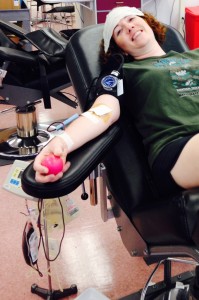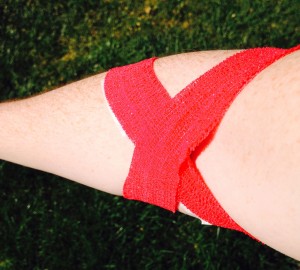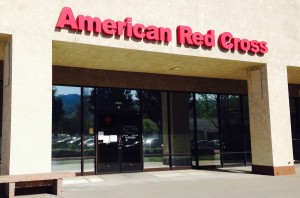On March 15, 2006, a British guy named Andy slipped away from the world, just three months and one week after he’d been diagnosed with cancer. He was 36 years old.
I knew him better as “Beasty,” a nickname he’d given when he wandered into an Internet chat room in 2000. He was a nerdy computer guy who liked corny jokes and was very proud of all the blood he’d donated over the years. His cancer diagnosis put an end to his blood donations, and I told myself I would finally get around to donating blood in his honor. Excuse followed excuse — how I had a weird reaction to a shot (couldn’t breathe, my hands froze up like claws, happy birthday to me); how my blood pressure is borderline low so they might not accept me anyway; how I couldn’t do it X amount of days before a long run or race. Years passed as I continued to avoid it.
Then, this year when I was coming up with my list of 36 things to do, something made me think, “donate blood.” I looked up Beasty’s online journal, which is still there in “memorial” status, and I looked up the newspaper column I wrote upon his death. It suddenly hit me: He was 36 years old when he died. 36. I went to my drafted list, scrolled to the bottom spots that were still empty, and typed “Donate blood” in number 36.
In February, when I started my “36 things in a year” attempt, I went to the American Red Cross site, found a local donation center, and learned that they were closed on the anniversary of Beasty’s death, March 15, a Sunday. But they were open March 14, which also happened to be Pi Day (a cool one at that: 3/14/15 at 9:26:53 made up the first digits of pi). Beasty would have gotten such a kick out of that! I looked at my calendar, knowing it might be a bit of a risk due to training for my first century bike ride, but I signed up anyway.
Yesterday found me in the Red Cross center closest to my house, where they apparently don’t get a lot of first-time donors. I went into a room with an employee and answered a bunch of questions to screen my blood — nope, I’m not a needle user and haven’t lived overseas, etc. They pricked my finger and tested to make sure my hemoglobin levels were ok — nope, I’m not anemic and my iron levels are fine. So then I went out into the main room where the lady put me in a reclining chair and pondered my veins. And then she called over the most senior employee for help.
I’m often the “problem patient” and this was no exception, as they tried to find a vein. They did find one, and I looked away as they poked the needle in my arm. It hurt but really wasn’t bad at all. It took awhile for them to get the blood, and they readjusted the needle several times (ouch) in an attempt to get it to flow faster. I’d read that it takes 8-10 minutes, but at eight minutes I was only halfway done. The head lady said they have a limit of 20 minutes, due to clotting worries. Fortunately, I was done in about 15 minutes.

They bandaged me up (that was pretty minimal, thankfully), brought me juice and made me sit there for about 10 minutes before going over to the food/drink area. I was supposed to eat something there and sit for another 15 minutes. I forced down a cookie thing and finally left, realizing it was 80 degrees outside, much warmer in my car, but I didn’t run the air-conditioning. I also realized I had no energy to stop at the grocery store as I’d planned. Walking up my stairs was exhausting. That was the beginning.
As my poor friends on Twitter and Facebook and texting know, I spent the afternoon and evening on my couch, griping about feeling woozy and about the blood pounding and swirling in my head and ears. I knew I needed to eat, but I could not find the energy to cook the dinner I’d planned — and it didn’t help that I was so NOT hungry to the point of almost feeling sick. I kept drinking water as instructed, and I actually was not dehydrated for once. But I guess losing about 10 percent of my blood sent my body into a bit of shock. (The human body contains 10-12 pints of blood and one pint is taken during donation, so it’s 8.5 to 10 percent total.) When I remembered that I needed to put clean sheets back on my bed, I actually started crying because it seemed like an insurmountable task. I finally forced myself to open and heat a can of soup, since it was 82 degrees in my apartment but I was still cold and at least soup would be warm. That helped quite a bit. I went to bed at 9, slept soundly until 3:10, then managed to get back to sleep until 6:30. That also helped. As I type this at 10 a.m., I’m doing a lot better. I took myself to Panera and bought food, so I would actually eat it despite not feeling hungry. I don’t feel as lethargic, so I think I have enough strength to go run an errand soon.
For those who have not donated, I still think you should do it if you are able. If you’re an endurance athlete, be prepared to lose some training time. Don’t plan to exercise the first 24 hours after donating, and also know that it takes two to six weeks for the body’s blood to be fully replenished. I read that a lot of athletes only donate in the late fall/early winter after their racing season has ended, and I think that’s a good plan. I didn’t want to wait that long to cross it off my list, and I also thought it would be neat to do it on the anniversary of my friend’s death.

After my experience, I won’t donate again until after I’m done with endurance events for the season. I will also be better prepared, with a food plan ready and knowing I’ll be useless and upset for the rest of the day. Honestly, I’m not in a hurry to donate again, because of terribly how I felt. HOWEVER, I still firmly believe that more of us should donate. Blood saves lives, and we all know people who’ve been saved with blood. It’s not even a political matter such as deciding whether to donate money to a cause: Even the richest, most successful people cannot buy their way out of a car wreck or a health emergency that requires blood to save their lives. A friend of mine, whom I’ve know for three decades, is alive today because of two organ transplants, which he could not have prevented. Google tells me that he went through at least 20 to 40 units of blood for just the liver transplant — and my donation was just one unit. One car wreck victim can require dozens of units of blood, such as this guy who went on to become an Ironman finisher. Imagine your child, parent, significant other or friend, lying in an emergency room bed, hooked up to a machine that is pumping blood into them to keep them alive until surgeons can stop the cause of the bleeding. That’s made possible because of donors.
And that’s why my friend Beasty donated. Just as he actually liked helping clueless people figure out how to operate a computer program, he liked donating blood. It was something he could do for others. In February 2006, just a few weeks before he died, he wrote about being informed that his cancer treatments meant he wouldn’t be able to blood again: “I think I did my bit, though, by giving 34 units while I still could. Being a rare blood group too, I’ll be missed. I was hoping to get to at least a hundred in my useful lifetime, but, alas, it is not to be. Annoying, but life goes on. I, for one, intend to make sure it does.”
Beasty, yesterday was for you. Between the two of us, you’ve now donated 35 units.

—
That newspaper column I wrote is linked here, though the date is wrong — that’s the date I contacted them and asked them to put it back online because the old link had stopped working. In case that link dies again, I’m putting the full text here.
An e-mail brings jarring news about ’Net friend
The e-mail arrived last week. It was from my closest friend, and the subject line contained one name. A sense of dread filled me.
As quickly as the thought came, I dismissed it. It must simply be an update on our mutual friend who was diagnosed with cancer a few months ago.
It was an update of the worst kind. At age 36, Andy had died of cancer.
As another mutual friend put it best, he wasn’t supposed to die. He was supposed to beat the disease. After all, I know three people who recently conquered cancer, and two of them were older than he.
Andy was a typical “British bloke.” He’d spent his life in England, unless he was off doing things like scuba diving off the coast of Florida or grilling burgers in San Diego.
He’d had a few career switches, for a time working in customs and occasionally seeing people busted for trying to smuggle drugs. But one of his passions was computers, so that was a big part of his life.
When I met him six years ago, I knew him as “Beasty.” He had wandered into an Internet community I called home, and before long he was making daily appearances. Like most of us, he used a different name online.
His name, though, belied his personality. For some reason I don’t quite understand, Beasty didn’t mind giving computer help to the most ungrateful, clueless people — and on his own time, too.
If complete strangers complained about a computer problem, he’d instantly offer to help.
But that was Beasty, the carefree guy who once got a kick out of recording words on his computer and sending them to me, simply because I liked his British accent.
Many people are scared of the online world. When they hear I’ve met “Internet friends” in person, they’re shocked.
Even one computer-savvy friend of mine recently remarked that the crazed, scary people online outnumber the decent people.
I challenge that assumption. We only hear about the psychotic situations; people like Beasty don’t make headline news.
As in all walks of life, there are crazed, scary people. We’ve all heard of horrible abductions and rapes and murders.
The Internet world is just like the physical world. Sure, you can’t see the people you meet, but that’s sometimes an advantage. When I meet people online, I’m not distracted by the surface appearance. I look deeper, and I keep looking until I find the real person.
When Beasty first wandered into that Internet community, I had no idea he was a blond-haired, blue-eyed guy with an intriguing accent. I didn’t know his age or marital status.
But I did learn those things later. Like many other people I’ve met online, I gradually got to know Beasty, eventually coming to know him by both his online and real names.
When he attended one of our annual gatherings in San Diego and we met in person, Beasty was how I’d thought he would be. What none of us had expected was for him to voluntarily take over the barbecue duties and continue cooking until there was food for more than two dozen hungry people. He loved doing it, too, and got a kick out of the fact that he’d traveled all that way to grill burgers
Over the years, people come and go from our lives. But Beasty made an effort not to lose track of people. Every year, he’d send me a birthday greeting, one time with the news that I now share a birthday with one of his closest friend’s babies.
When he was diagnosed last year with Deep Vein Thrombosis, we wished him well and didn’t worry too much. After all, he was so upbeat that it didn’t matter.
(According to the National Institutes of Health, DVT is a condition when a blood clot forms in a leg. It occasionally happens to people who take very long airline flights that require sitting for hours on end. Beasty didn’t know why he got it, but figured it was hereditary.)
For Beasty, one of the biggest concerns about having DVT was that he had to go on medication that would halt his blood donations. He’d donated 34 units by last year, and had wanted to reach some kind of record.
Then in the fall he went to the doctor to find out why he had a lump in his neck. In December, tests revealed it was cancerous.
His upbeat British humor dominated every new medical event, and Beasty resigned himself to radiation and chemotherapy — even apologizing in advance that he might miss my recent birthday because he’d be in the hospital then.
He kept us updated, and in late January came this line: “Well, I get to be a bigger enigma to the medical profession every day it seems.” In the lighthearted update, he also mentioned that he had diabetic symptoms and had developed a brain tumor.
After finishing radiation in mid-February, Beasty knew his blood donor days were over. “Annoying, but life goes on. I, for one, intend to make sure it does,” he told us in an update.
Then, on March 10, he awoke to find that his leg was’t working. None of his Internet friends, myself included, knew that would be his last message to us.
Five days later, he died.
His updates had come by Internet, and news of his death also came that way. It may sound impersonal, but in a way it’s not. The Internet has given all of his grieving friends a place to gather and remember him.
The tributes have been steady since we got word of Beasty’s death. Many, like myself, have been going through computer archives, recalling conversations and digging up photos to pass on to his grateful family members.
In each photo, there is Andy’s grinning face, a tribute to the person who was as genuine in person as he was online.

I have only ever donated blood once, and that was after 9/11 when I wanted to something – anything- to “help”, even though by that time, blood wasn’t needed. I remember feeling woozy afterwards, but not to the extent that you felt. Reading your account makes me realize that I should donate more often then I do, especially since I have Type O blood (aka universal donor). Good for you for getting into the clinic and finally making that donation. I’m sure Beasty would be proud!
I can’t believe Andy died so long ago. I can’t believe Andy died so recently, either.
I’m happy that you were able to donate blood recently. Beasty would be proud.